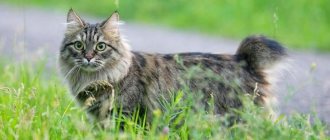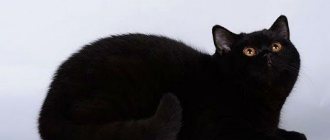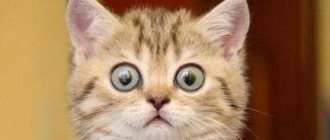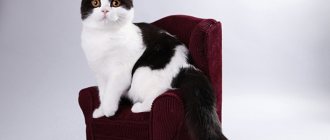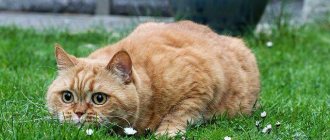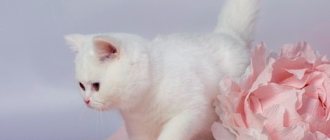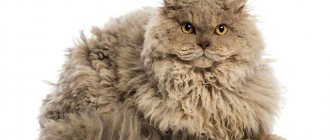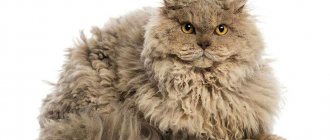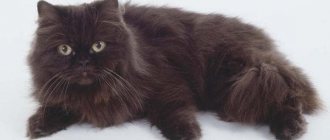How nice it is on cold winter evenings to drink hot tea, watch your favorite films and warm yourself under the blanket. But something is clearly missing from this picture. We know! A warm, fluffy and soft friend who will purr quietly next to you and create even more comfort. A British cat is perfect for this role. You've probably seen photos of these yellow-eyed beauties who can win the heart of anyone. But before you get yourself such a pet, we suggest you learn everything about the character of these feline aristocrats, how they eat and how to maintain their health.
History of the breed
We would like to say right away that the breed of British cats is far from new. Despite the fact that no documents have been preserved about the origin of the British, researchers have their own quite plausible version of the origin of the ancestors of modern four-legged aristocrats. According to them, around 43 AD, Roman centurions brought very large cats to the British Isles to catch rats and mice that carried various diseases.
All this time, fluffies were faithful assistants to people, and they began to invent breeds for them: in Britain they were called the British cat, in France - Charteuse, and in Germany - they were called Cartesian cats. Until the end of the 16th century, they were used and perceived exclusively as hunters, but people were still interested in the curious appearance and color of the cats.
And in 1817, British cats visited their first exhibition in London. There, the breed standard and its characteristics were adopted, and the four-legged fluffies themselves began to actively conquer human hearts.
This cat breed appeared in Russia more than 100 years later - in 1992. At the same time, the Kartheusers, who are considered the predecessors of modern Britons, were brought into the country.
By the way
To ensure that the unique traits of British cats were well preserved and passed through the centuries, breeders resorted to a little trick - they crossed Britons with Persian cats. This fact answers the question why these aristocrats have a slightly flattened muzzle.
Tail
It should be short, thick, tapering to a rounded tip, sort of like a log. But, often, the tail is too long for a given breed, and thin and not well dressed, or noticeably tapering towards the tip.
| tail of correct shape and length | the tail is too long, noticeably tapering towards the tip |
Breed characteristics
The cold climate and high humidity greatly affected the formation of the special features of British cats. It is because of this that they have such thick fur and dense undercoat, which protect the four-legged animals from low temperatures. Nevertheless, excessive “fluffiness” or, conversely, too short hair is considered a deviation from the norm. Therefore, we will tell you about the breed standards of British cats:
- the skull is wide, making the head look like a perfect round ball. The British also have peculiar cheeks, which is why the muzzle also looks round and slightly flattened;
- The eyes are set wide and have a perfectly round shape. The color of the eyes sometimes depends on the coat, but generally they are orange or golden in color with a dark rim and brown spots;
- The British nose is quite wide and small;
- Compared to the size of the head, the ears are quite small, have rounded tips, and are set wide and low;
- The body is quite large, the chest is voluminous. It is also worth noting that these cats, as excellent hunters, have well-developed muscles. So, if they run, jump and perform other “acrobatic” tricks, then they do them very skillfully;
- The limbs are quite strong, but short. And of course, everyone’s favorite part - the round and soft paws, with good hair between the pads;
- the tail of the British is thick and quite fluffy (especially in those moments when they are scared);
- If we talk about weight, it is quite impressive: adult cats weigh about 10-13 kilograms, and male cats - 6-9 kilograms.
As we said earlier, these cats are very well protected from the cold by their dense undercoat. The British fur itself does not adhere to the body, and if you stroke a cat, you will be surprised at how pleasant and literally plush they are to the touch.
By the way
The British coat is not always short. There are also cats with long hair. However, the parents of such a kitten must also have long hair.
We would like to immediately draw your attention, taking into account all the above characteristics of this breed, that British cats and Scottish cats (Scottish Straight) are two completely different breeds. Don't confuse them.
Now let's talk about color. If you thought that the British only come in blue, then we want to make you happy - no. There are a huge number of coat color options for these four-legged animals, let’s try to list them all:
- blue - the coat color is smoky gray without any spots, the skin also has a blue tint;
- lilac - yes there is such a thing. This coat shade is achieved through a combination of blue and pink. By the way, the nose and paw pads will also be purple;
- chocolate is a very beautiful and rich color. Taking into account the size of the British cats, cats of this color will suit the most real aesthetes;
- charcoal black is a rather difficult color for breeding kittens, since over time the fur of babies fades, acquiring a gray tint;
- white - these cats cannot have spots or inclusions of a different color. The coat tone is usually cool, and the skin, nose and paws are soft pink;
- cinnamon - strongly resembles the color of cinnamon. One of the varieties of brown color;
- faun - the name is truly magical, in fact, like the appearance itself. The shade of the fur seems to have been achieved by mixing pink and creme brulee;
- smoky - this effect is achieved if the undercoat is several tones lighter than the main coat;
- silver chinchilla - the name speaks for itself. The coat has a very interesting color: the chest can be completely white, and on the back this shade gradually turns into a soft gray;
- golden - the coat is completely golden in color, but there are slight darkenings at the tips. Spots or patterns are not allowed;
- tortoiseshell - characteristic exclusively of cats. This color sometimes combines two or even three colors that evenly cover the entire body of your four-legged friend;
- tabby - cats with this color have spots and oddly shaped patterns all over their body. Moreover, the colors can be completely different: brown, gray, beige and white.
British cats also have spotted colors:
- bicolor - in this case, white color predominates on the coat, but it is important that it does not occupy more than half of the entire body;
- harlequin—predominance of white (at least 5/6);
- color point - the fur of a quadruped has two shades, among which the majority is white.
It is worth noting that British Longhairs can also have colors in a variety of shades and variations, but white and color point are not typical for them.
pixabay.com/
Description of appearance
The real pride of any Englishman - the British Shorthair cat - has many features. People who are far from felinology may confuse its description with another breed, for example, Scottish. However, the British are very different from their short-haired fellow tribesmen, primarily in their thoroughness in everything - from appearance and character to physiological aspects of maturation.
British Shorthair cats have the following description in the standards:
- Body: closer to large in size. Powerful, all parts are wide, developed, strong. The limbs and neck are short and visually massive. The Briton looks stocky. The tail is proportional to the body, short, rather dense;
- head: round, massive muzzle, has full cheeks and pronounced large whisker pads. The British are distinguished by excess skin around the head, which gives it additional volume. The presence of a transition to the profile and a pronounced chin. Short nose, quite wide. There is no stop. The ears are medium-sized, widely set;
- coat: very dense, short, equipped with a thick undercoat. Tactilely creates a feeling of plush;
- British colors: a subject of both pride and controversy. Everyone is accepted without exception. Thoroughly described and systematized by standards - thoroughness was evident even in this;
- eyes: all options are possible, provided they match the color. The British often have all shades of yellow, but can also have blue and green. True, kittens are born, as a rule, with dull, gray eyes.
Character
Both owners and breeders note that the British are very independent and tolerate loneliness well. Therefore, if you want to get yourself a cat, but at the same time you work a lot and come home solely to sleep, then the British will be an excellent option. At the same time, they love their owners very much and become attached to every member of the family, without making any exceptions.
This breed of cat especially shows its love by constantly being close to its owner, as if looking after him. So don’t be offended that these four-legged aristocrats don’t sleep on their knees and rub against your face—they are very restrained in their feelings.
As soon as guests come home, the British can hide and not leave their shelter for a long time. The fact is that they prefer to study strangers from the outside. At the same time, these cats are completely unobtrusive, clean and, what is very important, very smart.
But still, don’t forget to pay attention to your furry one. The British are very demanding in this regard. Therefore, to maintain a good and friendly relationship with your pet, you will have to constantly talk to him, feed him, clean the tray on time, play and, of course, pet him and show tenderness.
By the way
You should only show your love for a British cat if the cat is in a good mood. Otherwise, your tailed friend will regard the owner’s actions as a vile violation of personal boundaries. At best, the cat will run away, but there is a high probability of a “tooth attack”, so be careful.
If there are other animals in the house, then a purebred British kitten will easily and quickly find a common language with them. It is also very important that these fluffies get along very well with children and become the best friends for kids.
Content Features
As we said earlier, the British people have quite good and good health. However, despite this, cats need proper and careful care. It will not only keep your tailed friend healthy, but will also help avoid various problems.
It’s worth starting with the fact that the British themselves are very inactive and lazy. Therefore, owners need to regularly play with the animal and monitor its physical activity. Otherwise, the cat will suffer from joint diseases and suffer from excess weight in old age. By the way, the nutrition of these cats is also special, but we will talk about it a little later.
The coat also requires care - the pet must be combed regularly and thoroughly to make it comfortable in the apartment. To do this, buy a massage slicker brush or furminator. These devices will rid your cat of excess undercoat, and will make it easier for you to clean the house, because there will be much less hair on the floor. Usually it is enough to comb your Briton only twice a week. As for bathing, these cats are washed as needed or a couple of times a year.
By the way
If you use clay clumping litter, your pet's fur may develop an unpleasant, dusty odor. It is easy to get rid of if you wipe the animal’s fur several times a week with special wipes, which can be purchased at any pet store.
Don't forget to wipe your eyes! With the British, these hygiene rituals are carried out daily - with a damp cotton wool it is necessary to carefully remove the natural secretions that form in the outer corner of the eye. The ears are examined several times a month and cleaned with a cotton swab dipped in a hygienic solution.
To avoid problems with teeth, they also need to be examined every day. Yes, the cat will have to be patient, but the owner should adapt and do it quickly. To make the inspection process easier, get your kitten accustomed to it from childhood - this will greatly simplify the task in the future. And lastly, do not create drafts at home, since the British are very sensitive animals in this regard. Because of the cold wind, they can get a bad cold, and you have to admit, it won’t be easy to watch a cat constantly sneezing.
pixabay.com/
Nutrition
We promised to tell you about nutrition, and now the time has come. Let us immediately draw your attention to the fact that a properly selected diet is the key to good health and excellent mood for your pet. Thick and beautiful coat, healthy teeth and strong claws are primarily the result of a well-balanced diet.
Moreover, recognizable brands and advertising are not always an indicator of the quality of food for an animal, and besides, the British are very prone to being overweight. Therefore, to ensure that your cat’s food includes all the necessary vitamins and beneficial microelements, we recommend that you consult a veterinarian. A competent specialist will always help you accurately select food and calculate portions, which in turn will ensure good digestion for your cat.
The daily feeding rate is determined according to individual criteria and the age of the kitten or cat. For example, it is enough to feed an adult cat twice a day, but it is recommended to give food to a pregnant or lactating cat four to five times a day.
Veterinarians recommend breastfeeding for babies who are not even two months old. But in cases where this is not possible, cow's milk or even goat's milk is quite suitable for feeding. The main thing is to maintain frequency and give milk to the kitten every four hours.
After two months, you can slightly change the diet and slowly add porridge, boiled meat and dairy products to the menu. And after the furry baby is three months old, you can give him special canned food. The number of meals is gradually reduced until the cat turns one year old. Then it can be transferred to the norm of an adult animal.
FAT BRITISH CATS: PHOTOS OF BLUES
Let's show photos of beautiful fat British cats and cats. It should be noted that the cats in the photo are in good shape for this breed, without excess weight.
THE BIGGEST BRITISH CAT
At the moment, the largest British cat was found in the USA, nicknamed Benny. His weight was 16.8 kg.
THE THICKEST CAT IN THE WORLD
Yes, such animals are even included in the Guinness Book of Records. And then this nomination went to a ginger cat named Himmy. The owner fed the pet to a weight of 21 kg 300 g, waist circumference was 84 cm.
Some interesting facts
Britons are unusual cats, and this applies not only to their color and character. We found some interesting facts about these furry aristocrats that will surely delight you:
- The British, as we said earlier, are very lazy furry fellows. It is completely normal for them to spend the whole day lying in their house. Therefore, according to statistics, this breed of cat sleeps about 16-18 hours a day;
- The British have a good hunting instinct, so they can cope with rodents in one go;
- according to legend, the image of the famous Cheshire Cat was copied from a British shorthair cat;
- Representatives of this breed are famous long-livers, because with proper care, these tailed animals can live up to 20 years.
The British will not leave a single person indifferent. If you decide to purchase a kitten of this breed, then know that you are getting yourself a real bundle of happiness and love that will bask next to you and bring you joy every day.
Siamese color - for blue eyes
If in front of you is a British cat with blue eyes or a British blue-eyed cat, with almost 100% probability we can say that this is a color-point animal (it is also called Siamese or acromelanic).
British cats with blue eyes can have six variants of the “Siamese” color - black, blue, chocolate, lilac, red and cream. We can say that these are the real lucky ones, because if a cat has blue eyes, then, as the song says, nothing will be denied to her!


